Vegetable Chow Mein Recipe calls for flat rice or wheat noodles with broccoli, carrot, and tofu that is stir-fried with a homemade sauce. A wide range of veggies can be added to these fried noodles with egg, making it a complete meal. This recipe is far better than takeout and is quite quick and easy to make!
A lot has been written about chow mein, and it is one of those foods that has gone global. Growing up in India, chow mein was a popular, standard, ‘go-to’ dish that was available pretty much anywhere there was a Chinese restaurant. My mom would sometimes use a different recipe to make Vegetable Chow Mein in a few minutes for me, whenever I was hungry after school.
When we visited Shanghai, and I asked for chow mein in a popular food court, I still remember the hawker giving me a somewhat bemused look by saying, “You’re asking for fried noodles. But what type of fried noodles?” That was the beginning of my exposure to the myriad varieties in which chow mein is made.
What is chow mein?
That is a particularly apt question. ‘Miàn’ (which is sometimes transliterated to ‘mein’) refers to wheat-based noodles, whereas ‘fěn’ refers to rice-based noodles. The phrase ‘chow’ or ‘chao’ just means fried or stir fried. But as the Chinese diaspora spread, so did the context of these noodles. Would it surprise you to find that there are over a thousand types of noodles. Any noodle that is made of wheat and fried could be called ‘chow mein’ or ‘fried wheat noodles’, while ‘chow fun’ means ‘fried rice noodles’. If you visit Southeast Asia, where there is a prevalence of people who speak Hokkien, you may hear ‘miàn’ referred to as ‘mee’ ~ think Mee Goreng and fěn referenced to as ‘hún’ or ‘sua’ as in hô-hún.
What about the global variations? In India, you can find fried noodles served with and without gravy, depending on the restaurant. It can be served with seasonal vegetables or even paneer (Indian cottage cheese). When I visited Caribbean, I sampled the ‘tjauwmin’. There are even differences between the East and West Coast here in the U.S. In the East Coast, when I asked for Vegetable Chow Mein, I was given a crispy noodle surrounded by gravy, whereas in the West Coast, the recipe called for stir-fried veggies with soy. The bottom line is, just as the Chinese diaspora is global, so follows the innumerable variations of these fried wheat noodles.
This brings me to my own version. My Vegetable Chow Mein Recipe is one that was inspired by my visits to Hong Kong, which makes this version more Cantonese in its profile. The reason I’m fond of this recipe is that it represents the best of Chinese cuisine. It uses sauces, but it highlights the essential quality of Chinese food: the freshness and unique flavor that each ingredient brings in a carefully balanced and harmonious meal.
Types of soy sauce:
Given that the global varieties of ‘chow mein’, let me talk a little bit of the types of sauces that are generally used. The first and most obvious is the ubiquitous soy sauce. Soy sauce is the liquified form of fermented and brined soybeans that have been processed and strained. There are at least seven types of soy commonly available today, although most soy-using nations have their own versions.
- Light: Generally, light soy sauce is a thin sauce, and although it generally contains less sodium in comparison to the darker variety, it has a saltier flavor. You could even use the low sodium soy sauce.
- Dark: Dark soy sauce, while being less salty, has more sodium. The saltiness is to a large degree subsumed by the greater amount of sugar that is added. This makes the dark soy thicker, sweeter, while packing a heavier soybean flavor.
- Dark and sweet soy:
- Kecap Manis: You will find a variant of the dark soy which is even sweeter. It is not exactly soy sauce but is more a sauce that has a soy base. You may also find that its more common in Indonesian and Southeast Asian cooking and is called ‘kecap manis’ which more or less means ‘sweet sauce’. This is a form of flavored soy (think mushroom soy), but is heavily flavored by spices such as anise, pepper, clove, palm sugar, and cinnamon, resulting in a molasses like sticky and thick consistency.
- Hoisin: Another version of fermented soybeans, but hoisin is usually made from garlic, sesame oil, chilis, vinegar, and some form of sugar or other sweeteners. Like the kecap manis, it also has a molasses-type consistency.
- Tamari is often misunderstood as the standard gluten-free alternative to traditional soy which has wheat in it. It is a byproduct of producing miso sauce and while it can have no wheat, there is no guarantee of that. Check the label for the list of ingredients before assuming that all Tamari are created equally.
- Double Fermented: This is soy sauce that is fermented a second time alongside wheat, and you guessed it: soy. This results in a stronger soy sauce, and some would say it has more ‘umami’ in it.
- White soy: White soy isn’t white. Its more of golden or rosé. This is the result of soy being produced with a higher percentage of wheat as compared to soy.
These are generally the basic types of soy, but as I said, there are dozens of variations based on the country of origin, flavor additions, the ratio of wheat and other agents to soybeans, and of course, sugar. Depending on which type of fried noodles you prefer, you can use one or more of these soy sauces. In my Vegetable Chow Mein recipe, I also use both dark and light soy as well as a dash of hoisin to produce umami that balances salt and sweetness, which allows the flavor of the fresh vegetables. I find that the hoisin perks the dish up and reminds me of the noodles I had in Hong Kong.
What is the difference between chow mein and lo mein?
In case you were wondering about the difference between chow mein and lo mein noodle dishes, chow mein is made with thinner and flatter noodles and is generally fried, making them slightly crispy. On the other hand, lo mein uses noodles that are more rounded and cooked or tossed with the sauce.
Ingredients in the Vegetable Chow Mein Recipe:
- Veggies: Other veggies that you could use in the Vegetable Chow Mein are shiitake, bamboo shoots, green beans, beansprouts, cauliflower, baby corn, water chestnuts, bok choy, and Chinese cabbage.
- Noodles: Whole wheat, thin flat noodles, egg noodles, or even linguine
- Sauces: I have used the Cantonese iteration where both dark and light soy sauces are used. I did not add sugar or cornstarch as dark soy sauce has molasses and is thick. I have also used a dash of hoisin for the additional ingredients/flavor of chili and other ingredients such as sesame and garlic. A dash of rice vinegar rounds off the flavor and gives the noodles the depth and balance. Vegetarian oyster sauce can be used instead of hoisin sauce.
- Oil: I have used a combination of peanut and toasted sesame oil. Toasted has low smoke point and is more aromatic than sesame oil and lends a deep flavor. I begin stir-frying with peanut oil and then add toasted sesame oil along with the sauces.
- Ginger, garlic: I like using fresh garlic and dry ginger. Fresh ginger can also be used. You can find it in any Asian grocery stores.
- Scallions: Green onions or scallions may be used.
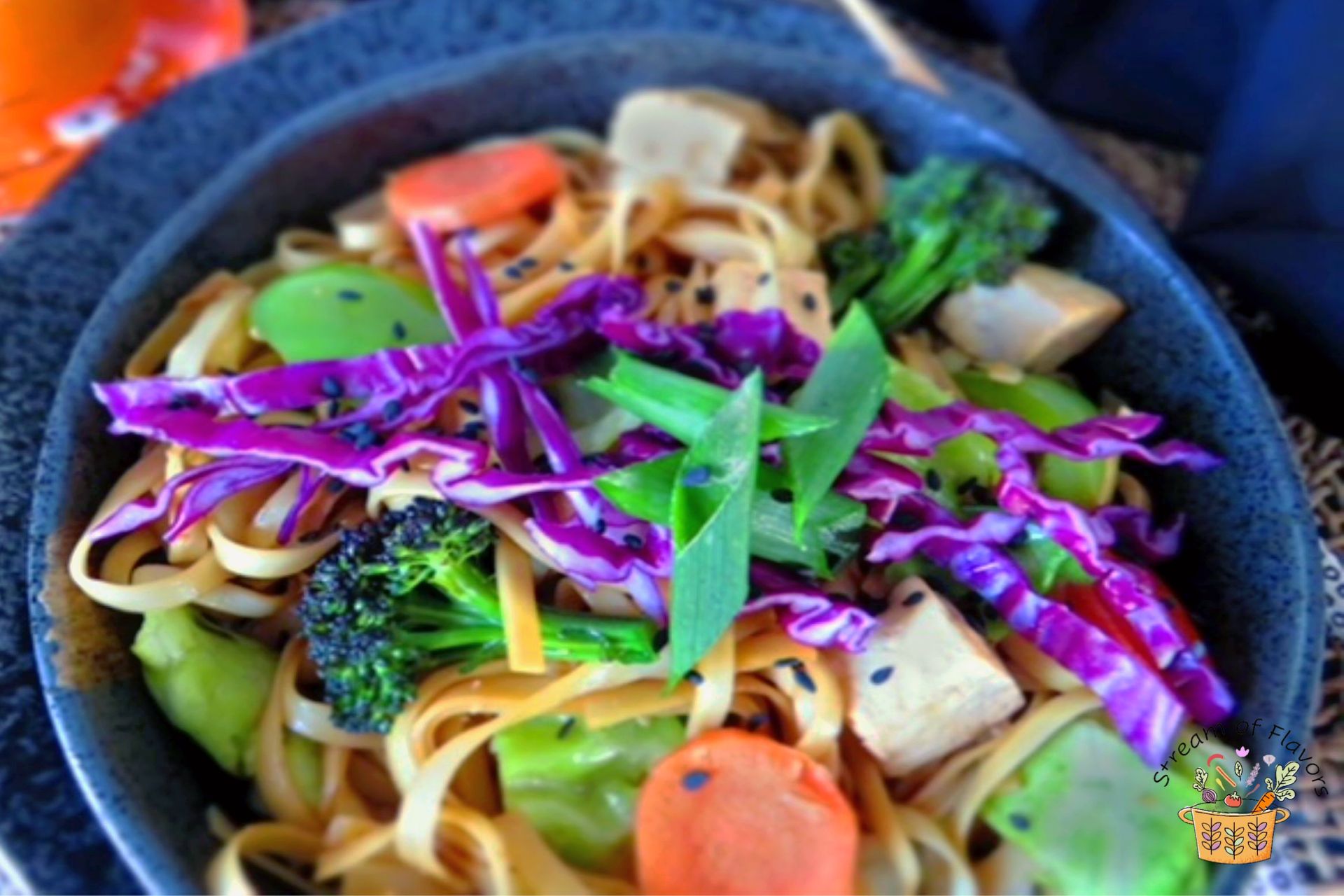
How to make the Vegetable Chow Mein using my recipe:
- How to make the sauce:
- How to stir-fry the noodles:
- How to make the sauce:
- Mix the ingredients for the sauce together in a bowl and keep aside.
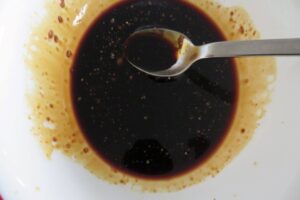
2. How to stir-fry the noodles:
- Prepare by chopping the vegetables and tofu and keep them ready.
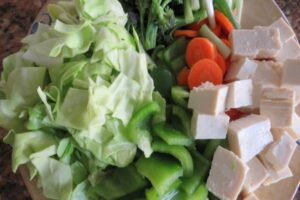
- Heat a wok to high and add the peanut oil. Add all the veggies (except cabbage) and tofu with the garlic and ginger and sauté on high heat for two minutes. Keep stirring constantly and then add the noodles.
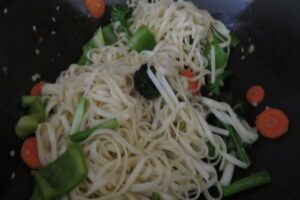
- Stir the noodles for a few seconds and then add the cabbage.
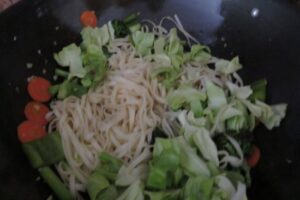
- Pour the sauce mixture and the toasted sesame oil in to the wok and toss the noodles for another minute.
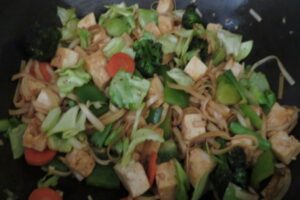
- Plate while still hot and garnish with scallions, shredded red cabbage and black sesame seeds. Drizzle a few drops of chili sesame oil on top.
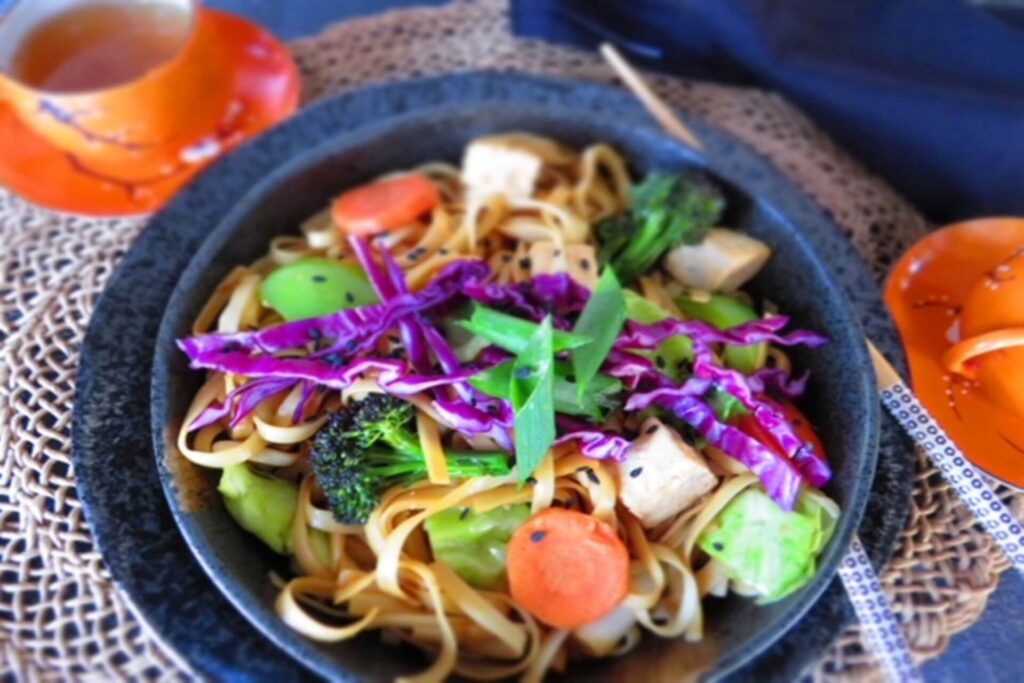
1. Do not add hot noodles to the wok. Cool the noodles thoroughly on a tray and cook or soak for a minute less then the package directions. Additionally, rub with some oil to prevent the noodles from sticking. You could pat dry or blot with a kitchen paper if the noodles are still wet. Some chefs prefer to fry the noodles in oil before making the dish. I have made it with less oil unlike the restaurant-style fried noodles.
2. Keep scraping the bottom of the wok and stirring continuously on high heat. Some parts of the noodles can be browned for added flavor.
3. Add the soft leafy veggies last or they will become mushy.
4. Prepare the veggies, cook the noodles, mix the sauces and then turn on the heat to make this dish.
Storage:
Vegetable Chow Mein can be refrigerated for 2-3 days and frozen in airtight boxes for three months. While reheating, drizzle some oil, add the noodles and add some soy sauce at the end. You could even break an egg and stir-fry with the noodles.
Other noodle dishes that you might love to make:
Vegetable Chow Mein Recipe
Equipment
- Wok
Ingredients
For the chow mein:
- 1 tsp peanut oil
- 1½ tsp toasted sesame oil
- 1½ tsp ginger peeled, chopped fine
- 2 clove garlic chopped fine
- 4 scallion
- 1 carrot sliced
- 1 pepper sliced
- 8 floret broccolini
- ½ pack tofu firm
- 1 pack chow mein noodle
- ½ cup green cabbage chopped
- ⅓ cup red cabbage (optional) shredded for garnish
- 1 tbsp toasted black sesame seeds optional for garnish
- 1 tsp chili sesame oil optional
For the sauce:
- 1 tbsp dark soy sauce
- 1½ tbsp light soy sauce
- 1 tsp rice vinegar
- ½ tbsp hoisin sauce
- 1½ tsp chili sesame oil
Instructions
How to stir-fry the Vegetable Chow Mein:
- Prepare by chopping the vegetables and tofu and keep them ready.
- Heat a wok to high and add the peanut oil. Add all the veggies (except cabbage) and tofu with the garlic and ginger and sauté on high heat for two minutes. Keep stirring constantly and then add the noodles.
- Stir the noodles for a few seconds and then add the cabbage.
- Pour the sauce mixture and the toasted sesame oil in to the wok and toss the noodles for another minutes.
- Plate while still hot and garnish with scallions, shredded red cabbage and black sesame seeds. Drizzle a few drops of chili sesame oil on top.
Notes
- I did not add sugar since dark soy sauce has molasses in it. But you could add a pinch of brown sugar if you like it a bit sweeter.
- I did not use oyster sauce but instead a small addition of hoisin rounds off the flavor. You could opt to use the vegetarian oyster sauce.
- As you fry the veggies and noodles, keep stirring and scraping the bottom of the wok, adjust the sauce and season to your liking.
Nutrition


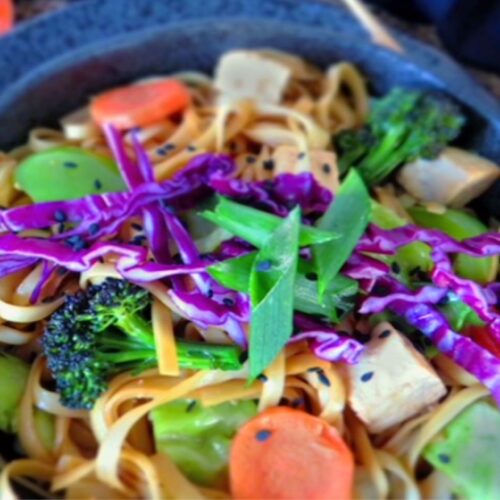
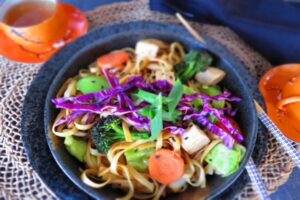





















0 Comments